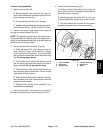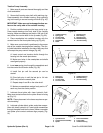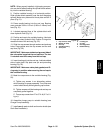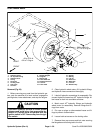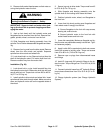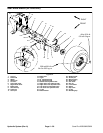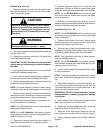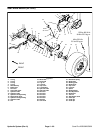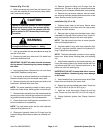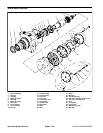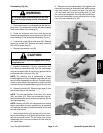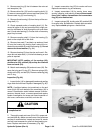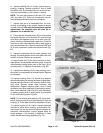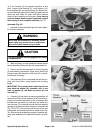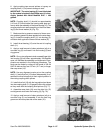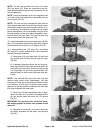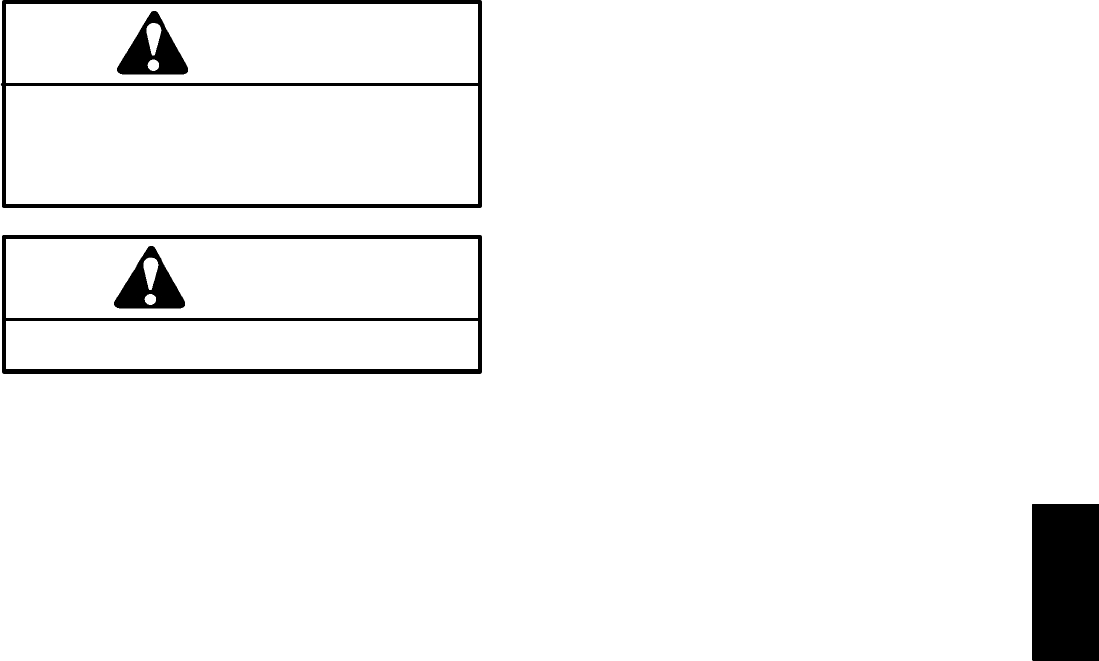
Removal (Fig. 57 or 58)
1. Before removing any parts from the hydraulic sys-
tem, park the machine on a level surface, lower attach-
ment, and stop the engine.
CAUTION
draulic oil. Controls must be operated with the
tion switch.
Operate all hydraulic controls to relieve system
pressure and avoid injury from pressurized hy-
ignition switch in OFF. Remove key from the igni-
WARNING
Before jacking up the machine, review and follow
Jacking Instructions in Chapter 1 – Safety.
2. Jack up rear wheel and use wood blocks to keep the
rear tire off the floor.
3. Remove lug nuts from drive studs. Pull wheel from
drive studs and wheel hub.
IMPORTANT: DO NOT hit wheel hub with a hammer
during removal. Hammering may cause damage to
the motor.
4. Apply parking brake. Remove lock nut from wheel
motor shaft. Release parking brake.
5. Use a puller to remove brake drum and wheel hub.
Remove woodruff key from the wheel motor shaft.
6. Remove retaining clip securing the cam shaft to the
brake lever. Separate lever from cam.
NOTE: The brake assembly consists of return spring,
brake cam, brake shoes, backing plate, and anchor pin.
7. Remove brake assembly from the brake bracket by
removing four lock nuts and cap screws from the back
-
ing plate and brake bracket. Do not disassemble.
8. Clean wheel motor and hydraulic connections. La-
bel all connections for reassembly.
NOTE: The right wheel motor has an extra hydraulic
tube and fitting attached to it.
9. Disconnect hydraulic tubes and O–rings from the
hydraulic fittings. Allow tubes to drain into a suitable con
-
tainer.
10. Remove hydraulic fittings and O–rings from the
wheel motor. Put caps or plugs on disconnected tubes
and motor ports to prevent contamination from entering.
11. Remove hex cap screws, spacers, and lock wash-
ers securing the brake bracket and wheel motor to the
frame. Remove motor from the frame.
Installation (Fig. 57 or 59)
1. Position wheel motor to the frame. Secure motor
and brake bracket to the frame with four cap screws,
spacers, and lock washers.
2. Remove caps or plugs from the wheel motor. Lubri-
cate new O–rings with clean hydraulic fluid. Install O–
rings and hydraulic fittings to the motor and tighten.
NOTE: The right wheel motor has an extra hydraulic
tube and fitting attached to it.
3. Lubricate new O–rings with clean hydraulic fluid.
Install O–rings and hydraulic tubes to the hydraulic fit
-
tings. Tighten tube connections.
NOTE: The brake assembly consists of return spring,
brake cam, brake shoes, backing plate, and retaining
clip.
4. Install brake assembly to the brake bracket by se-
curing the backing plate to the brake bracket with four
cap screws and lock nuts. Secure brake lever to the
brake cam with the retaining clip.
IMPORTANT: DO NOT hit wheel hub with a hammer
during installation. Hammering may cause damage
to the motor.
5. Install woodruff key to the wheel motor shaft. Slide
brake drum and hub onto the motor shaft.
6. Secure lock nut to the wheel motor shaft. Torque nut
from 250 to 400 ft–lb (34.6 to 55.3 kg–m).
7. Install rim to the drive studs. Secure rim with lug
nuts. Torque nuts from 40 to 50 ft–lb (5.5 to 6.9 kg–m).
8. Charge hydraulic system (see Charge Hydraulic
System).
Hydraulic
Systems
Sand Pro 2020/3020/5020 Page 4 – 61 Hydraulic System (Rev. A)



